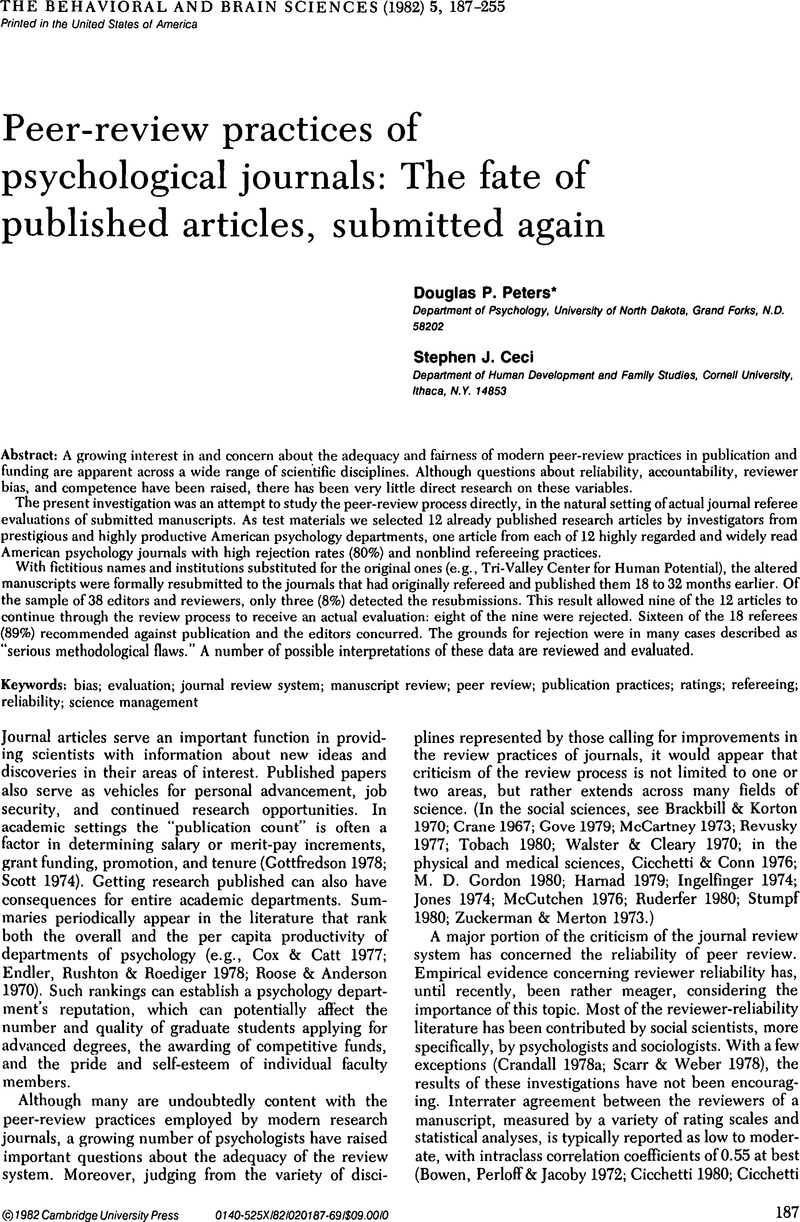
Feb 01, · Faster-turnaround and open-access journals such as AERA Open can certainly play a role here, but it is all but certain that most policy makers and practitioners will struggle to take findings straight from peer-reviewed research to the classroom or legislative chamber. This means that scholars must strive to publish their work in blogs, briefs Cited by: 6 Apr 02, · - present. Web of Science Core Collection is our premier resource on the platform and the world's most trusted citation index for scientific and scholarly research.. It is a curated collection of over 21, peer-reviewed, high-quality scholarly journals published worldwide (including Open Access journals) in over science, social sciences, and humanities blogger.com: Marisa Ruccolo In An evaluation of the peer review system in psychological research, chairman J. Demarest, open forum presented at the American Psychological Convention, Montreal. [taDPP] Google Scholar Trafford, A. () Behind the scandals in science labs
Understanding and improving core strength - Harvard Health Blog - Harvard Health Publishing
Think of your core muscles as the sturdy central link in a chain connecting your upper and lower body. Whether you're hitting a tennis ball or mopping the floor, the necessary motions either originate in your core, or move through it.
No matter where motion starts, it ripples upward and downward to adjoining links of the chain. Thus, weak or inflexible core muscles can impair how well your arms and core peer reviewed articles function.
And that saps power from many of the moves you make. Properly building up your core cranks up the power. A strong core also enhances balance and stability. Thus, it can help prevent falls and injuries during sports or other activities. In fact, a strong, flexible core underpins almost everything you do:. Weak, tight, or unbalanced core muscles can undermine you in any of these realms, core peer reviewed articles.
And while it's important to build a strong core, it's unwise to aim all your efforts at developing rippling abs. Overtraining abdominal muscles while snubbing muscles of the back and hip can set you up for injuries and cut athletic prowess. If washboard abs are your holy grail, it's essential to trim body fat through diet and aerobic exercise and build strong abdominal muscles through frequent core exercise sessions.
Disclaimer: As a service to our readers, Harvard Health Publishing provides access to our library of archived content, core peer reviewed articles.
Please note the date of last review or update on all articles. No content on this site, regardless of date, should ever be used as a substitute for direct medical advice from your doctor or other qualified clinician. Published: January, Our FREE E-mail Newsletter.
In each core peer reviewed articles of HEALTHbeat: Get trusted advice from the doctors at Harvard Medical School Learn tips for living a healthy lifestyle Stay up-to-date on the latest developments in health Receive special offers on health books and reports Plus, receive your FREE Bonus Report, " Tips for Tip-Top Health".
E-mail Address. First Name Optional.
Identify a Peer Reviewed Article
, time: 2:46CORE – Aggregating the world’s open access research papers

In An evaluation of the peer review system in psychological research, chairman J. Demarest, open forum presented at the American Psychological Convention, Montreal. [taDPP] Google Scholar Trafford, A. () Behind the scandals in science labs Microsoft partnered with CORE to link documents in the Microsoft Academic Graph with open access articles in CORE, as the datasets complement each other. The outcome is the world’s largest scholarly graph with both bibliographic information, including citations, and full texts of academic papers for machine processing This was a peer reviewed electronic journal which deals with research concerning inclusive education with scholarly contributions from faculty and graduate students. Acceptance rate was approximately 20%. This journal is no longer being published
No comments:
Post a Comment